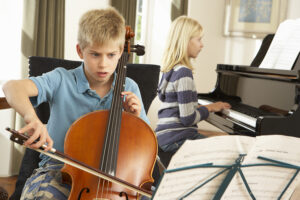This article covers basic concepts for intermediate to early advanced piano students in their first accompanying endeavor. Thoughts shared here assist in establishing the role of the pianist when accompanying and how this differs from solo playing.
Piano Accompanying Is An Art

As a piano teacher, I’m very excited to have several students studying the art of accompanying with me, as it is a true passion and something I’ve always enjoyed as a pianist. Why? It’s fun to work with other musicians, and for me, I like the fact that I play a crucial part in performing a piece while not having to be in the spotlight. Leave that to the soloist!
However, it may seem that you are off the hook if “all you are doing” is accompanying, but “all you are doing” is actually tremendously different than solo playing and an art all its own. Also, just because you are an accompanist doesn’t necessarily mean the pieces are easier, and there are other factors to consider when fulfilling this role.
The first few lessons I do with my students in piano accompanying speak to establishing the correct mindset of a non-soloist and are expanded upon as they begin to work with others. Here are a few tips I like to share with beginner accompanists and have been successful points to remember throughout these types of lessons.
You Are Not the Soloist!

The first lesson in accompanying is to understand the role of the piano part in this new setting. The piano part is not the focus of the listener if you are accompanying, and it is just support in the background of the main instrument (the soloist). The more a student realizes this in the beginning, the easier it is to work towards the goal of being a great foundation for another instrumentalist. The dynamic balance between the instruments (volume) will favor the soloist (meaning, don’t play too loud and cover up the main part), and the accompanist will be present, but not in the “spotlight” by the audience’s perspective.
You Are the Foundation!
As the stable, supporting part of the musical texture, a piano accompanist must be able to play his or her part with excellent continuity and response to the main instrument. Aspects like tempo continuity and rhythmic accuracy have a heightened importance, especially when preparing for the first rehearsal with the person or group you are accompanying.

So How Do You Practice a Piece from an Accompanying Perspective?
- Listen to a Recording of the Piece: It’s always a great first step! Especially on first accompanying experiences, it’s great to have the extra context of knowing what end result you are working towards and to hear what the main part sounds like.
- Practice with a Metronome: After doing the initial preparation of reading through the piece and practicing difficult areas, get out the metronome! It’s important to ask the instrumentalist you are accompanying to give you the desired performance tempo of the piece. As the accompanist, you must meet this tempo and be able to play through without losing track of the beat, as you will not be able to back track and correct errors. You have to support the forward motion of the piece at all times.
- Simplify Difficult Passages: Because you are working towards fluid tempo continuity, you may find that you need to simplify some difficult passages in the accompaniment part if they are not coming together in time for a rehearsal or performance. This is okay, and what you should do is take out “inner voices” and preserve the lowermost bass line and upper voice. For example, if several chords in a row are difficult to play in quick succession, take out the middle notes, and just play the outside voices. Another example is, if you have embellishments (like trills or grace notes) that slow you down, leave them out! Ideally, we would all like to play the piece exactly as it’s written, but this may not be a feasible goal if you want to have great continuity. Your teacher will be able to help with any simplifications, but you can also see where this idea can be applied in preparation.
- Respond to the Instrumentalist: The overall goal of an accompanist is to follow and support. This means, if the instrumentalist is doing a ritardando (slowing down gradually), you must respond in the same way. If you are accompanying a singer and she needs to take a breath, you must respond by giving time for the breath to occur before starting the next phrase. The communication between the instrumentalist and accompanist can be established quite a bit through eye contact, but also general listening and adapting.
First Piano Lessons – Accompanying
I could go on for days about thoughts on accompanying, and the ideas shared here are just the tip of the iceberg. However, they are the fundamental first points for a student to master, and once his or her bearings are established, more specific techniques can be covered. The most important thing to remember is that accompanying is a lot of fun! So to students: look for opportunities to work with friends and family in your first accompanying experiences, and enjoy the versatility of your skill as a pianist!

My sister is thinking about putting her son in beginner piano lessons. She wants to be able to give her son a head start with some good tips. It might be good for him to know that being an accompanist means supporting the instruments.